“A satisfied customer is the best business strategy of all.” – Michael LeBoeuf.
Sounds about right, doesn’t it? To succeed in business, you need great products and top-notch services – that’s common knowledge. But what ensures you stay there, at the top?
The answer is customer satisfaction, and what better way to gauge it than by asking effective customer satisfaction survey questions?
In this blog, I’ll discuss the importance of customer satisfaction, its types, readymade templates you can use, and 100+ essential customer satisfaction questions to help you connect better with your customers and keep your business growing.
Watch: How to Create a Customer Satisfaction Survey
What Is a Customer Satisfaction Survey?
CSAT surveys are questionnaires designed to measure and quantify the level of satisfaction customers have with a specific brand, product, service, or interaction.
It asks customers to rate their satisfaction on a rating scale or provide feedback on their experience. Through these surveys, you can capture valuable insights that help you fine-tune your strategies, improve customer experiences, and build stronger relationships.
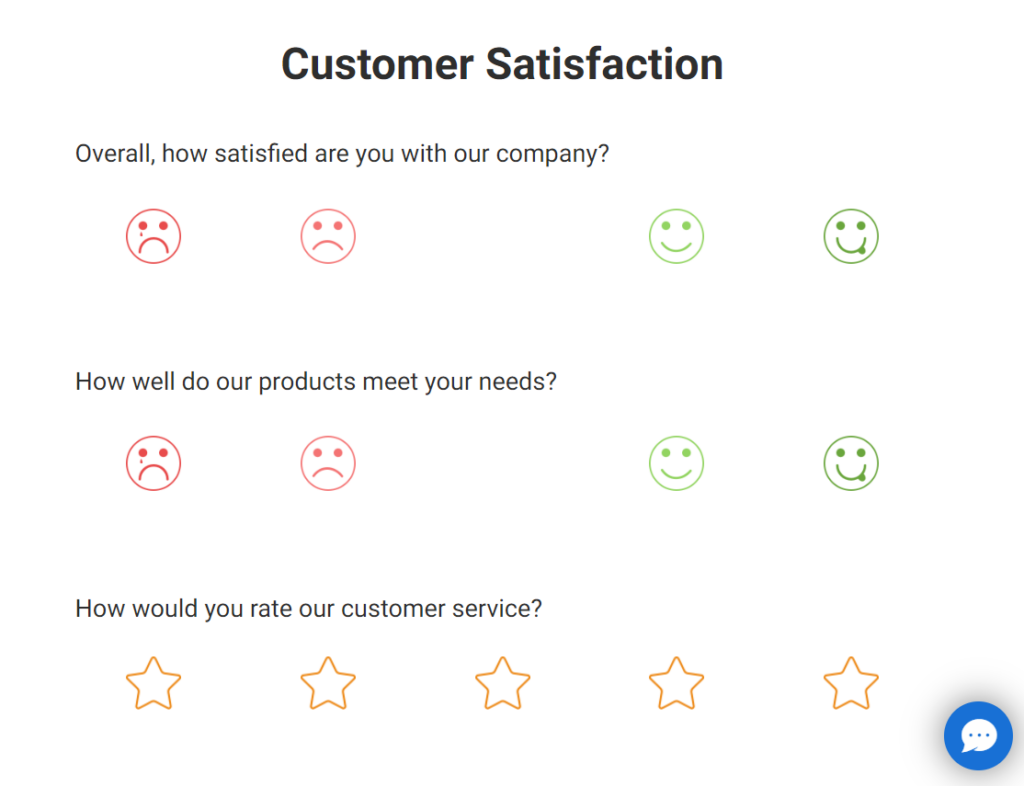
The impact of customer satisfaction on a business is huge. Studies have shown that a whopping 86% of consumers are willing to pay more for a better customer experience.
This powerful tool provides you with a structured way to measure customer satisfaction, identify areas for improvement, and gauge the overall success of your products/services.
By tapping into the thoughts and emotions of your customers, you gain a deeper understanding of what truly delights them and what may be falling short.
Why Are Customer Satisfaction Surveys Important?
Customer satisfaction surveys are more than just a tool for feedback collection; they are an indispensable part of a business’s strategy to understand, engage, and retain customers.
The benefits of conducting these surveys are manifold, but let us take a detailed look at some of the key advantages:
Enhanced Customer Retention
One of the primary benefits of customer satisfaction surveys is their ability to aid in customer retention. By understanding the needs, preferences, and issues your customers face, you can take targeted actions to address concerns, improve your offerings, and ensure that your customers feel valued and understood.
This encourages loyalty and fosters a sense of belonging among customers, making them more likely to stick with your brand in the long run.
Informed Decision-Making
Customer feedback provides valuable insights that can guide strategic decisions. Whether it’s improving product features, tweaking services, or adjusting customer service protocols, the data gathered from satisfaction surveys offers a clear direction based on actual customer preferences and experiences.
This data-driven approach minimizes guesswork and enables businesses to allocate resources more effectively, ensuring that efforts are concentrated where they can make the most impact.
Product and Service Improvement
Continuous improvement is the key to staying competitive, and customer satisfaction surveys provide direct input on where enhancements are needed. Feedback on products and services allows businesses to identify both strengths to build upon and weaknesses to address.
This ongoing loop of feedback and improvement ensures that offerings evolve in line with customer expectations, enhancing overall quality and user experience.
Benchmarking Performance
Surveys allow businesses to benchmark their customer satisfaction performance against industry standards or past performance. Tracking satisfaction levels over time helps understand how changes in products, services, or customer service practices impact customer perception.
This benchmarking is crucial for setting realistic goals and measuring progress toward enhancing customer satisfaction and loyalty.
Strengthening Customer Relationships
Asking for feedback is a gesture that shows customers you value their opinions and are committed to meeting their expectations. This can significantly strengthen the customer-business relationship, fostering trust and open communication.
Customers who feel heard are more likely to perceive the brand positively, contribute constructive feedback in the future, and recommend the business to others.
Identifying Advocates and At-Risk Customers
Surveys can help identify your brand advocates and customers at risk of churning. Satisfied customers can be nurtured into brand advocates, who are more likely to spread positive word-of-mouth and contribute to organic growth.
Conversely, identifying dissatisfied customers early allows businesses to address their concerns proactively, potentially salvaging the relationship and avoiding churn.
Cost Efficiency
Retaining an existing customer is significantly cheaper than acquiring a new one. By investing in customer satisfaction surveys, businesses can improve retention rates, reducing the need for constant acquisition efforts. This saves money and builds a stable customer base that contributes to ongoing revenue.
100+ Customer Satisfaction Survey Questions Examples
Here is a list of the top customer satisfaction questions you should ask your customers to gather incisive insights.
Each category of questions serves a specific purpose in gathering feedback, whether it’s understanding overall satisfaction, deep-diving into industry-specific details, assessing event success, or evaluating customer support.
Crafting your survey with a mix of these categories ensures a comprehensive view of customer sentiment, allowing for targeted improvements across all aspects of your business.
General Satisfaction Questions
These questions gauge overall satisfaction with a company, product, or service. They provide a broad understanding of customer sentiment.
- How satisfied are you with our product/service?
- Would you recommend our company to friends or family?
- Overall, how would you rate your experience with us?
- How likely are you to purchase from us again?
- Is our product/service meeting your expectations?
- How well does our product/service meet your needs?
- Can you rate your satisfaction with our product/service on a scale of 1-10?
- What would you change about our product/service to improve it?
- How does our product/service compare to other options you’ve tried?
- Overall, are you satisfied, dissatisfied, or neutral about our product/service?
Industry-Specific Satisfaction Questions
These questions delve into the nuances of specific industries, addressing unique aspects of customer experience.
-
Financial Services:
- How satisfied are you with the clarity of our fee structure?
- Were you able to easily access your account information?
- Did our financial advisor provide helpful guidance?
- How satisfied are you with the security of our online banking platform?
- Were you able to complete your transactions efficiently?
- How would you rate the responsiveness of our customer support team?
- Did we provide you with adequate information about your investment options?
- Are you satisfied with the performance of your investments?
- How likely are you to recommend our financial services to others?
- What could we do to improve your experience with our financial services?
-
Software:
- How often do you use our software?
- What do you use our software for?
- How easy is our software to use?
- How reliable is our software?
- How satisfied are you with the features of our software?
- How helpful is our software documentation?
- How responsive is our customer support team?
- How likely are you to recommend our software to others?
- What could we do to improve our software?
- What other software do you use?
-
Manufacturing:
- How satisfied are you with the quality of our products?
- How durable are our products?
- How easy are our products to use?
- How satisfied are you with the design of our products?
- How satisfied are you with the packaging of our products?
- How satisfied are you with the delivery of our products?
- How responsive is our customer support team?
- How likely are you to recommend our products to others?
- What could we do to improve our products?
- What other products do you use?
Healthcare Satisfaction Questions
These questions focus on patient experience, quality of care, and overall satisfaction with healthcare services.
- How satisfied were you with the level of care you received?
- How would you rate the communication skills of your healthcare provider?
- Did you feel comfortable asking questions and expressing concerns?
- Were your appointments scheduled in a timely manner?
- How clean and well-maintained were the facilities?
- How satisfied were you with the level of empathy and compassion shown by the staff?
- Were you provided with clear and understandable information about your treatment options?
- How would you rate the effectiveness of your treatment?
- Would you recommend this healthcare provider to others?
- What could we do to improve your experience at our healthcare facility?
Food and Beverage Satisfaction Questions
These questions assess customer satisfaction with food quality, service, ambiance, and overall dining experience.
- How satisfied were you with the taste of your food?
- How would you rate the presentation of your meal?
- Were your food and drinks served at the correct temperature?
- How attentive and friendly was the waitstaff?
- How satisfied were you with the cleanliness of the restaurant?
- How would you rate the atmosphere and ambiance of the dining area?
- Were your orders taken and delivered accurately?
- How long did you have to wait for your food?
- Would you recommend this restaurant to others?
- What could we do to improve your dining experience?
Ecommerce Satisfaction Questions
These questions target online shopping experiences, including website usability, product selection, shipping, and returns.
- How easy was it to find the products you were looking for on our website?
- How satisfied were you with the variety of products available?
- How would you rate the quality of the product images and descriptions?
- Was the checkout process smooth and secure?
- How satisfied were you with the shipping options and delivery time?
- Did you encounter any issues with your order?
- How easy was it to track your order?
- Have you ever used our customer support channels (e.g., live chat, email)?
- How satisfied were you with the return process?
- What could we do to improve your online shopping experience?
Hospitality Satisfaction Questions
These questions gauge guest satisfaction with hotels, resorts, and other hospitality services, focusing on comfort, amenities, and staff interactions.
- How satisfied were you with the cleanliness and comfort of your room?
- How would you rate the quality of the amenities provided (e.g., Wi-Fi, pool, gym)?
- Were the hotel staff friendly and helpful?
- How satisfied were you with the check-in and check-out process?
- Did you enjoy the food and beverage options at the hotel?
- How would you rate the overall value for money?
- Would you recommend this hotel to others?
- What could we do to improve your stay at our hotel?
- Did you feel safe and secure during your stay?
- How satisfied were you with the location and accessibility of the hotel?
Event Satisfaction Questions
These questions assess attendee satisfaction with events such as conferences, workshops, and festivals, focusing on organization, content, and value.
- How satisfied were you with the overall event experience?
- How would you rate the quality of the speakers/presentations/performances?
- Was the event well-organized and easy to navigate?
- Did the event meet your expectations?
- How relevant and informative was the content?
- How satisfied were you with the venue and facilities?
- Were you able to network and connect with other attendees?
- How likely are you to attend a similar event in the future?
- What did you like most about the event?
- What could we do to improve the event in the future?
Customer Support Satisfaction Questions
These questions measure customer satisfaction with support interactions, including responsiveness, helpfulness, and issue resolution.
- How satisfied were you with the speed of response from our support team?
- How knowledgeable and helpful was the support agent?
- Was your issue resolved to your satisfaction?
- How easy was it to contact our support team?
- Did the support agent communicate clearly and effectively?
- How satisfied were you with the support channels offered (e.g., phone, email, chat)?
- Did you feel valued and respected by the support agent?
- Would you recommend our customer support to others?
- What could we do to improve your experience with our customer support?
- Have you contacted our support team before?
Website and Mobile App Satisfaction Questions
These questions evaluate user experience with websites and mobile apps, focusing on design, functionality, and ease of use.
- How easy was it to navigate our website/mobile app?
- How satisfied were you with the design and layout of the website/mobile app?
- Did you find the information you were looking for easily?
- How would you rate the speed and performance of the website/mobile app?
- Did you encounter any errors or bugs while using the website/mobile app?
- How satisfied were you with the mobile app features (if applicable)?
- How likely are you to use our website/mobile app again?
- What did you like most about our website/mobile app?
- What could we do to improve our website/mobile app?
- How did you hear about our website/mobile app?
Pricing and Value Satisfaction Questions
These questions assess customer perception of pricing, value for money, and willingness to pay.
- How would you rate the overall value for money of our product/service?
- Do you feel our pricing is competitive?
- How satisfied are you with the pricing structure?
- Would you be willing to pay more for additional features or benefits?
- Are there any alternative products/services you considered before choosing ours?
- What factors influenced your decision to purchase our product/service?
- How does our pricing compare to our competitors?
- Do you feel you received good value for your money?
- What could we do to improve the value proposition of our product/service?
- Would you recommend our product/service to others based on its pricing and value?
Product Usage Frequency Satisfaction Questions
These questions explore how often customers use a product or service and their satisfaction with that usage frequency.
- How often do you use our product/service? (Daily, Weekly, Monthly, etc.)
- Are you satisfied with the frequency with which you use our product/service?
- What are the main reasons you use our product/service?
- Are there any obstacles preventing you from using our product/service more often?
- How could we encourage you to use our product/service more frequently?
- Do you feel you get enough value from your current usage frequency?
- How does your usage frequency compare to your expectations?
- What could we do to make our product/service more useful for you on a daily/weekly/monthly basis?
- Are there any features or functionalities you wish you used more often?
- How likely are you to continue using our product/service at your current frequency?
Try Our Ready-to-Use Free Survey Templates
Here are some free, readymade customer satisfaction survey templates for your use. You can use them as they are or customize them according to your requirements!
1. Customer Satisfaction Survey
This is a general survey used to gauge the overall satisfaction levels of customers regarding a product, service, or experience provided by a company. It typically covers various aspects such as product quality, customer service, ease of use, and overall experience.
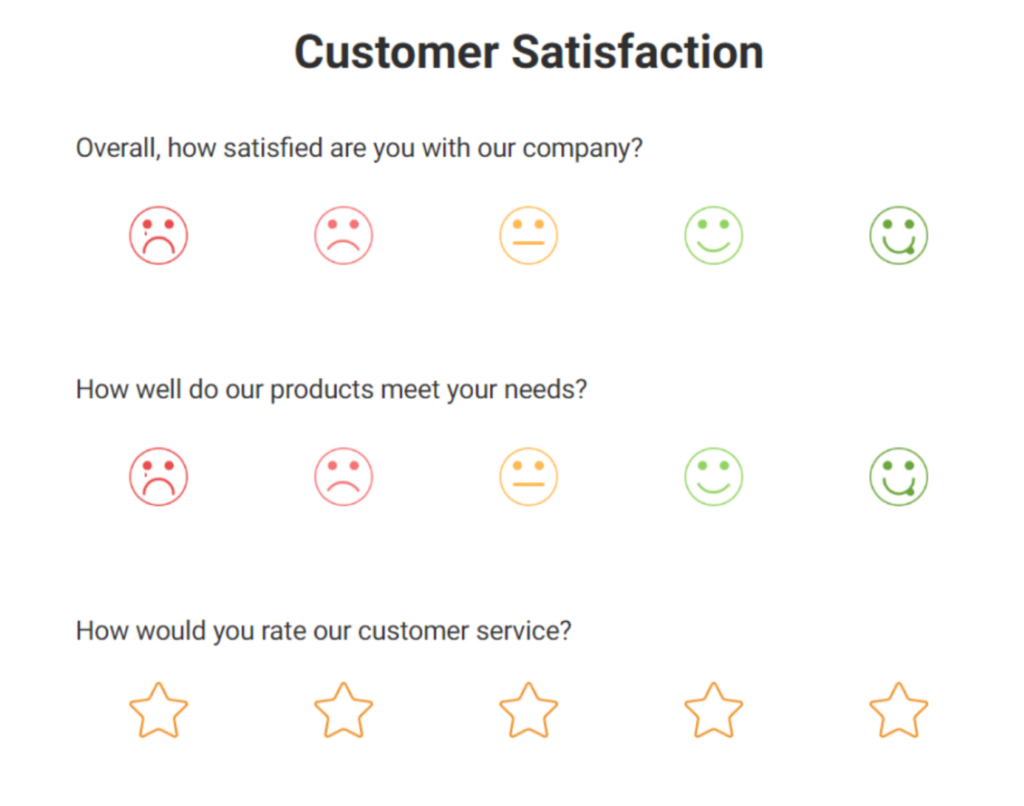
2. Customer Satisfaction NPS (Net Promoter Score)
This survey template assesses customer loyalty and their likelihood of recommending a product or service to others. It typically includes the NPS question (“How likely are you to recommend [company/product/service] to a friend or colleague?”) followed by an open-ended question for feedback.
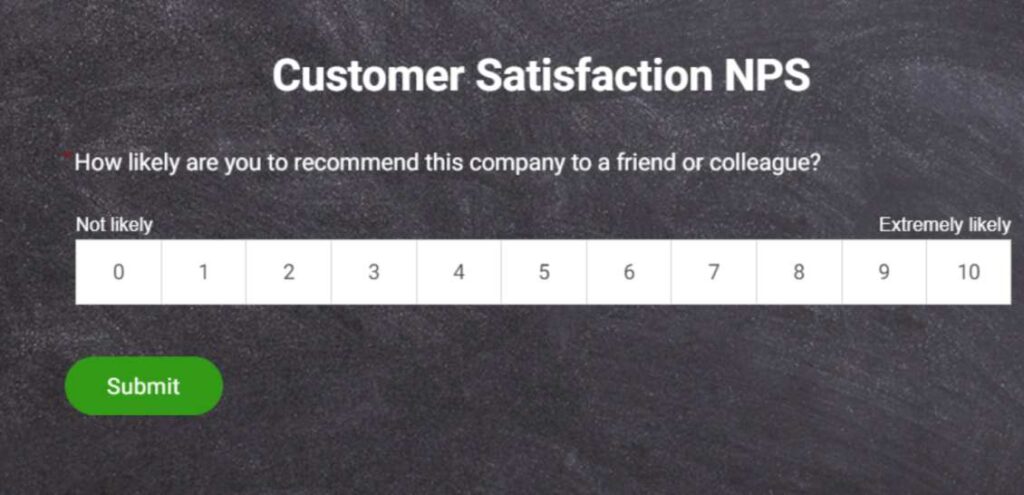
3. Product Satisfaction Survey
This template specifically targets customers’ satisfaction with a particular product. It may include questions about product features, functionality, performance, and overall satisfaction.
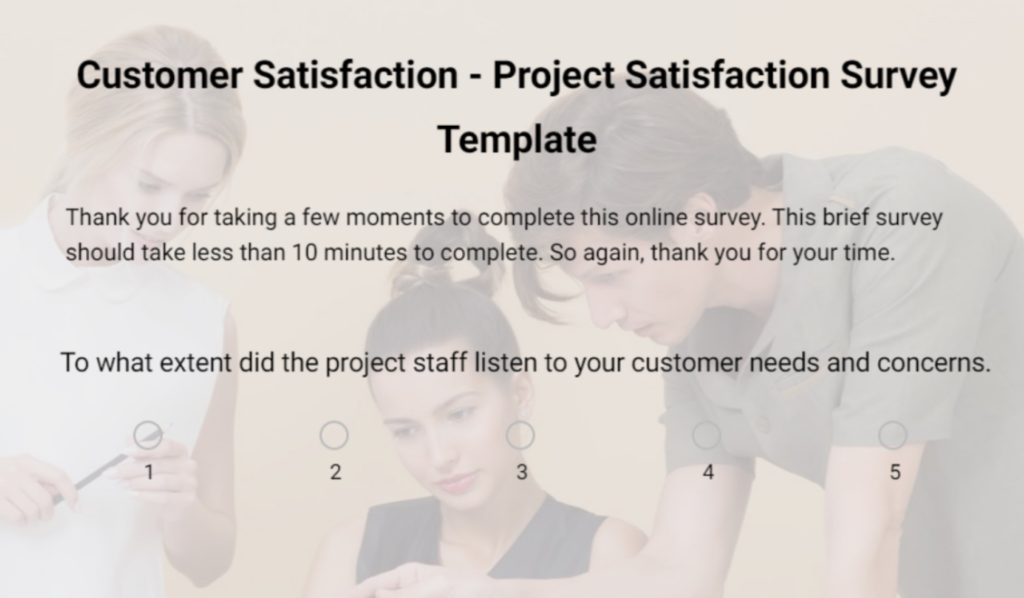
4. Restaurant Satisfaction Survey
The questions in this template focus on customers’ experiences at restaurants, including food quality, service speed, cleanliness, ambiance, and overall satisfaction.
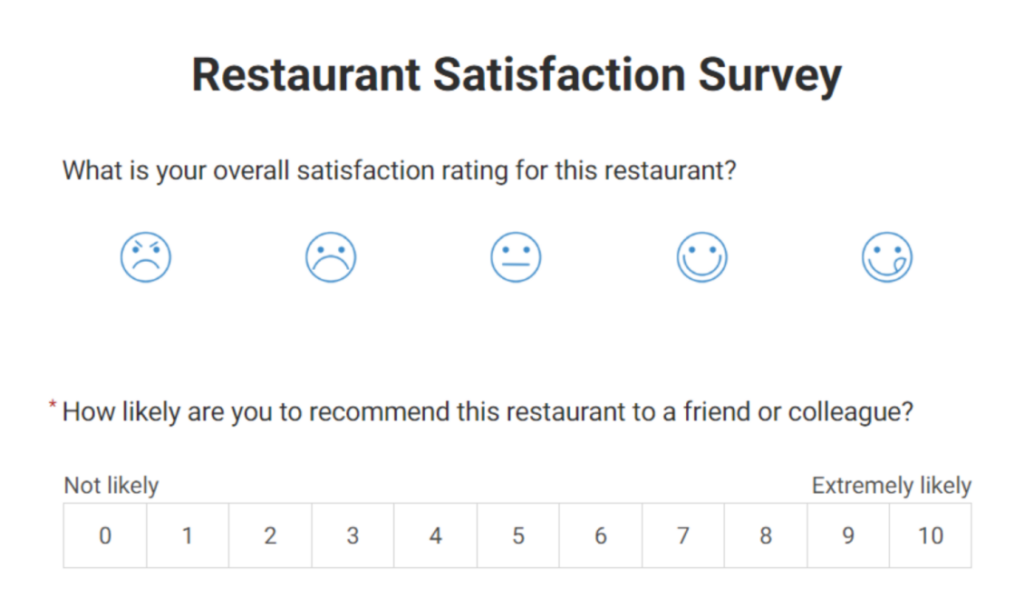

5. Website Satisfaction
This template focuses on users’ satisfaction with a website’s design, navigation, content relevance, functionality, and overall user experience.
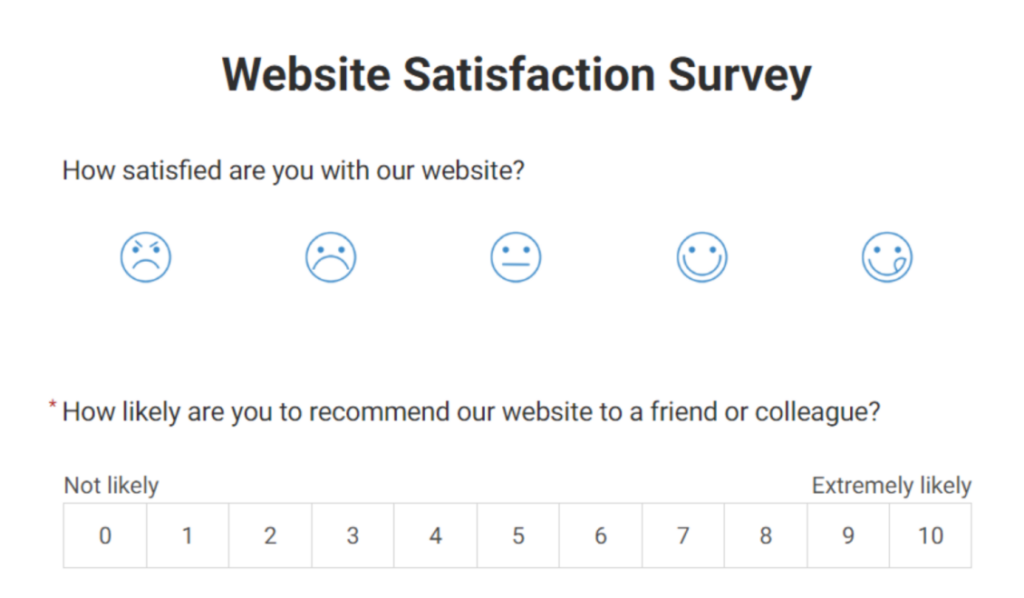

-
Project Satisfaction
This survey evaluates stakeholders’ satisfaction with a specific project, including project management, communication, deliverables, and overall project outcomes.



Similar to a general customer satisfaction survey, it is specifically tailored for company clients. It could include questions about client relationships, service delivery, responsiveness, and overall satisfaction.
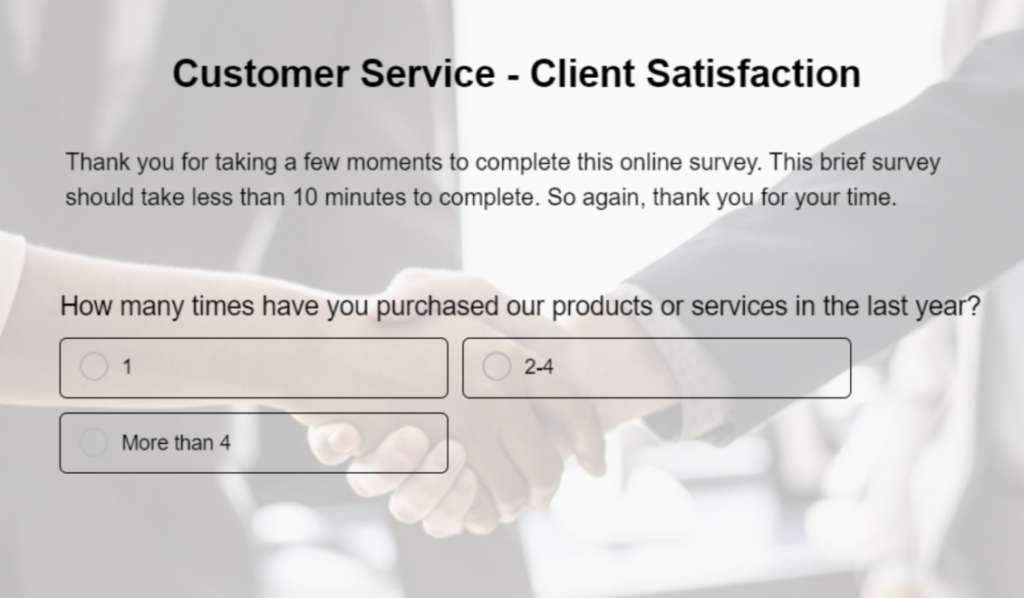

-
Information Technology
This template targets users’ satisfaction with IT services, including helpdesk support, system reliability, software usability, and overall IT infrastructure.
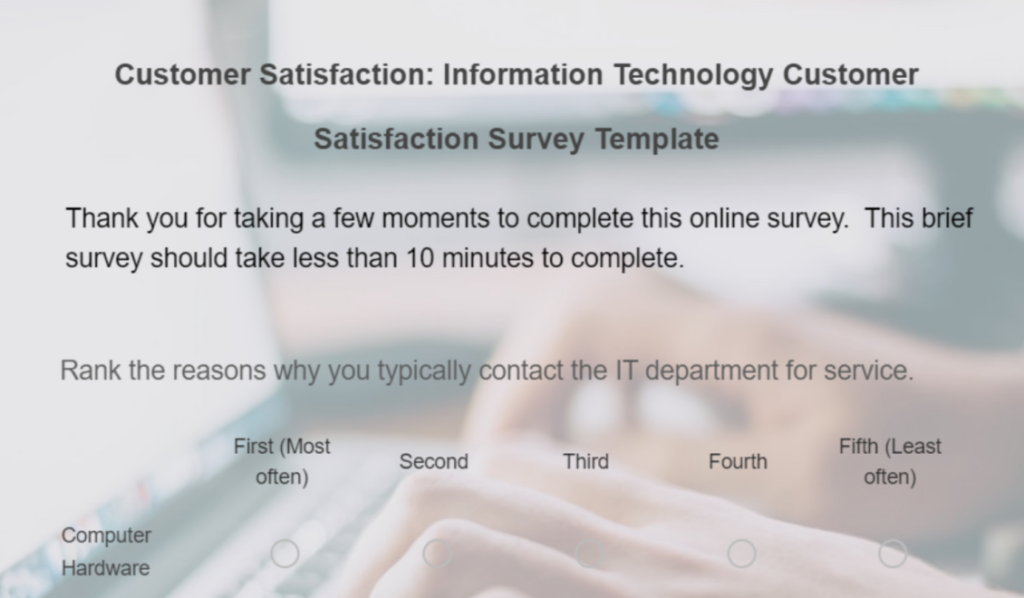

Questions in this focus on understanding factors influencing customer loyalty and retention. It may include questions about brand perception, likelihood of repeat purchases, and reasons for staying loyal to a company.
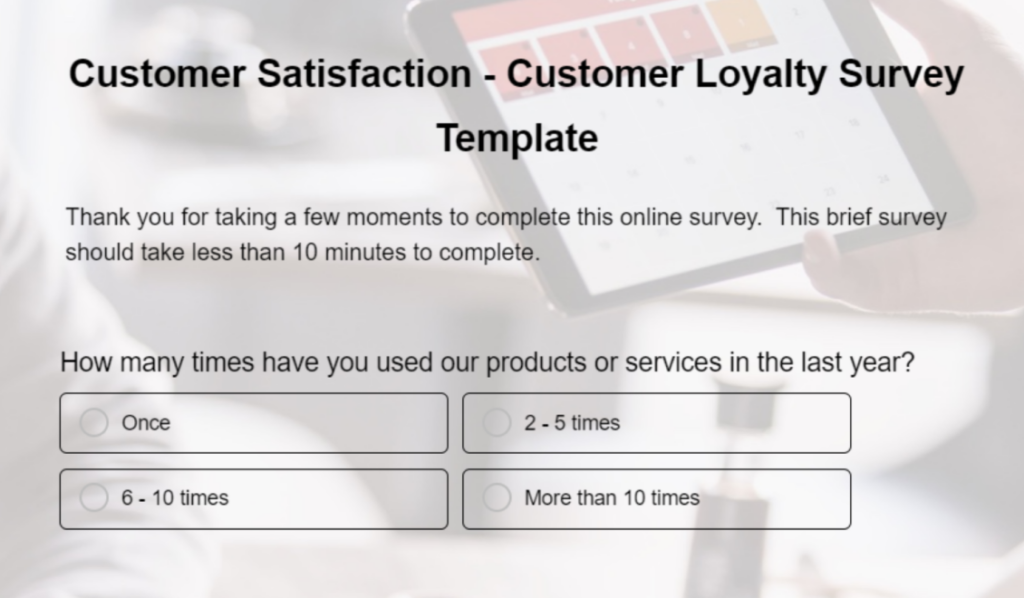

-
Retail Customer
The retail customer satisfaction survey template is designed to provide retailers with a direct line to customer insights, enabling you to enhance your service, product offerings, and overall shopping experience.
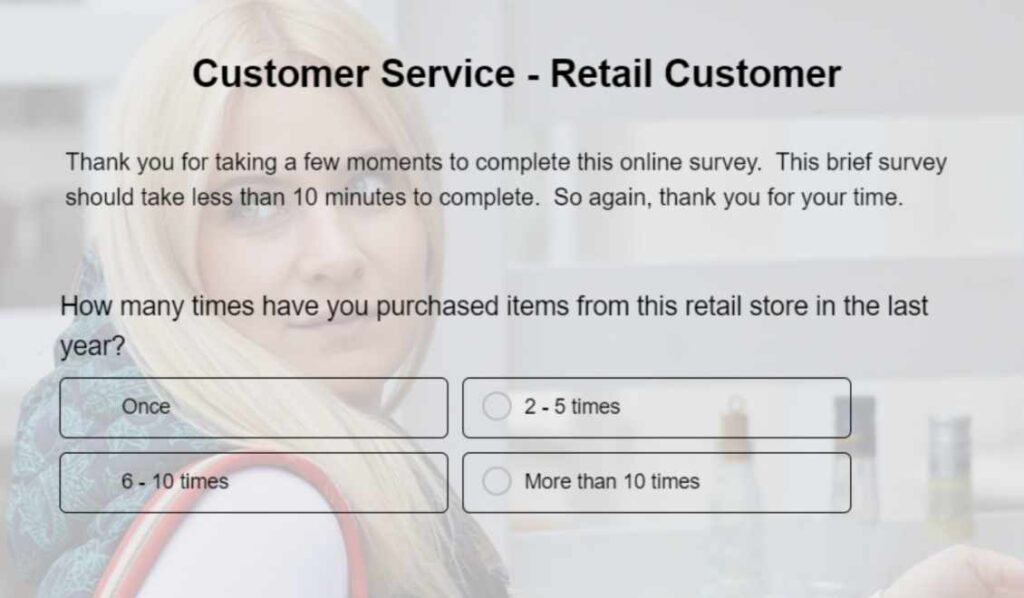

FREE. All Features. FOREVER!
Try our Forever FREE account with all premium features!
Best Practices for Running Customer Satisfaction Surveys
Let’s look at some tips and best practices to get the most out of your customer satisfaction surveys:
- Go beyond basic demographics: Segment customers based on their behavior (purchase history, website activity, support interactions) to tailor survey questions and get more relevant feedback.
- Personalized surveys = higher engagement: When customers feel like a survey understands their specific needs, they’re more likely to respond and provide thoughtful answers.
- Trigger surveys based on events: Trigger the surveys after key interactions like purchases, support calls, or free trial expirations. This captures feedback while the experience is fresh in the customer’s mind.
- Open-ended questions are crucial: Don’t just rely on numerical ratings. Always include open-ended questions like “What did you like most/least?” or “How could we improve?” to understand the reasoning behind their ratings.
- Omnichannel Feedback: Integrate feedback mechanisms into your website, app, social media, and even physical locations. Don’t rely solely on email surveys.
- Close the loop: Always act on the feedback you receive. Let customers know you’re listening and making changes based on their input. This builds trust and encourages future participation.
- A/B test your surveys: Experiment with different question wording, survey design, and even incentives to optimize response rates and data quality.
- Continuously analyze and improve: Regularly review your survey strategy, analyze drop-off rates, and make adjustments based on your findings and evolving customer needs.
Achieve Peak Customer Satisfaction – One Question at a Time
As a business that’s constantly evolving, your ultimate goal should be to achieve customer delight. With customers becoming smart, you’ve to be smarter and stay one step ahead. That’s how you will gain the competence to build the experiences your customers seek.
Before you share surveys, be clear about your objective and base your survey on that goal. Ask the right questions, choose the right timing, and ensure that your survey is aligned with the customers’ journey.
The best way to go about it is by choosing the right survey tool with features like AI surveys, readymade templates, pre-made questions to choose from, and a robust analytics dashboard. ProProfs Survey Maker fits the bill perfectly, so why wait?
Get a demo or get started free today!
Learn More About Customer Satisfaction Surveys: FAQs
- Why use customer satisfaction surveys?
Customer satisfaction surveys are essential for understanding how customers feel about your product or service. They help identify what’s working, what needs improvement, and how you can enhance customer loyalty and retention. - How do I measure customer satisfaction?
You can measure customer satisfaction by using methods like Net Promoter Score (NPS) to gauge loyalty, Customer Satisfaction Score (CSAT) to assess specific interactions, or Customer Effort Score (CES) to determine how easy it is for customers to get their issues resolved. - How to turn your customer feedback into action?
To act on customer feedback, start by categorizing responses into trends or themes. Prioritize issues based on their impact, implement necessary changes, and communicate those improvements back to customers to show you value their input. - How to build good customer satisfaction surveys?
To create effective surveys, use clear and focused questions that align with your goals. Include a mix of rating scales, multiple-choice, and open-ended questions, and keep the survey short to maintain customer engagement. - How long should a customer satisfaction survey be?
A customer satisfaction survey should ideally take no more than 3–5 minutes to complete. Keeping it concise, with 5–10 well-thought-out questions, ensures higher response rates. - When should you send a survey to your customers?
Send surveys after key interactions, such as a purchase, customer support resolution, or at regular intervals for ongoing services. Timing is critical—capture feedback while the experience is still fresh.
 Tips
Tips
We’d love to hear your tips & suggestions on this article!
FREE. All Features. FOREVER!
Try our Forever FREE account with all premium features!


 We'd love your feedback!
We'd love your feedback! Thanks for your feedback!
Thanks for your feedback!







